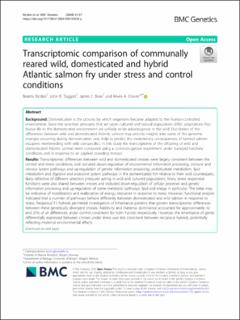| dc.contributor.author | Bicskei, Beatrix | |
| dc.contributor.author | Taggart, John B. | |
| dc.contributor.author | Bron, James E. | |
| dc.contributor.author | Glover, Kevin | |
| dc.date.accessioned | 2020-10-14T08:49:47Z | |
| dc.date.available | 2020-10-14T08:49:47Z | |
| dc.date.created | 2020-08-03T13:21:42Z | |
| dc.date.issued | 2020 | |
| dc.identifier.citation | BMC Genetics. 2020, 21:57 1-20. | en_US |
| dc.identifier.issn | 1471-2156 | |
| dc.identifier.uri | https://hdl.handle.net/11250/2682650 | |
| dc.description.abstract | Domestication is the process by which organisms become adapted to the human-controlled environment. Since the selection pressures that act upon cultured and natural populations differ, adaptations that favour life in the domesticated environment are unlikely to be advantageous in the wild. Elucidation of the differences between wild and domesticated Atlantic salmon may provide insights into some of the genomic changes occurring during domestication, and, help to predict the evolutionary consequences of farmed salmon escapees interbreeding with wild conspecifics. In this study the transcriptome of the offspring of wild and domesticated Atlantic salmon were compared using a common-garden experiment under standard hatchery conditions and in response to an applied crowding stressor. | en_US |
| dc.language.iso | eng | en_US |
| dc.title | Transcriptomic comparison of communally reared wild, domesticated and hybrid Atlantic salmon fry under stress and control conditions | en_US |
| dc.type | Peer reviewed | en_US |
| dc.type | Journal article | en_US |
| dc.description.version | publishedVersion | en_US |
| dc.source.pagenumber | 1-20 | en_US |
| dc.source.volume | 21:57 | en_US |
| dc.source.journal | BMC Genetics | en_US |
| dc.identifier.doi | 10.1186/s12863-020-00858-y | |
| dc.identifier.cristin | 1821336 | |
| cristin.ispublished | true | |
| cristin.fulltext | original | |
| cristin.qualitycode | 1 | |
